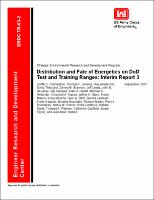Please use this identifier to cite or link to this item:
https://hdl.handle.net/11681/8557| Title: | Distribution and fate of energetics on DoD test and training ranges : interim report 3 |
| Authors: | Defence Research Establishment Valcartier Institut national de la recherche scientifique (Québec) BCR Polysyntech, Inc. AMEC Earth and Environmental Naval Explosive Ordnance Disposal Technology Center (U.S.) Science and Technology Corporation (Hampton, Va.) Cold Regions Research and Engineering Laboratory (U.S.) Strategic Environmental Research and Development Program (U.S.) Pennington, Judith C. Jenkins, Thomas F. Ampleman, Guy, 1954- Thiboutot, Sonia, 1962- Brannon, James M. Lewis, Jeff DeLaney, John E. Clausen, Jay L. Hewitt, Alan D. (Alan Dole) Hollander, Michael A. Hayes, Charolett A. Stark, Jeffrey A. Marois, André, 1959- Brochu, Sylvie Dinh, Hien Q. Lambert, Dennis J. Gagnon, Annie Bouchard, Melanie Martel, Richard Brousseau, Patrick Perron, Nancy M. Lefebvre, René Davis, William M. Ranney, Thomas A. Gauthier, Catherine Taylor, Susan Ballard, Jean-Marc |
| Keywords: | Detonation residues Dinitrotoluene Explosives Munitions HMX Partition coefficients Propellants RDX Test ranges TNT Training ranges Firing ranges Military installations Transformation rates Soil pollution |
| Publisher: | Environmental Laboratory (U.S.) Engineer Research and Development Center (U.S.) |
| Series/Report no.: | ERDC TR ; 03-2 rept.3. |
| Description: | Technical Report Abstract: Sustainment of training to maintain the readiness of our armed forces requires stewardship of human health and the environment. The objective of this project, initiated in FY00 and planned for completion in FY05, was to determine the potential for environmental contamination from residues of energetic materials on ranges. This report describes accomplishments for FY02. A U.S. and a Canadian site were characterized for explosives residues resulting from live-fire soldier training: Fort Bliss, Texas, and Canadian Forces Base (CFB), Shilo, Manitoba. Results are also reported on tests to determine residues associated with open detonations and low-order detonations and tests to define environmental fate and transport process descriptors. Results of intensive sampling at Fort Bliss indicated that judgmental sampling targeting low-order residues and firing points is superior to grid sampling for identifying potential point sources of contamination over the typically large training range areas. Furthermore, composite sampling offers the best opportunity of capturing a realistic concentration under the conditions of extreme heterogeneity. Results of open detonations tests confirmed that the use of C4 generates significant explosives residuals. In low-order detonation tests, controlling the percent energy yield of artillery projectiles proved difficult. Adjustments in the variables from these results will improve control of future detonation tests. At CFB Shilo, energetic materials found in soils were associated with targets, and propellants were associated with firing points. The Shilo ranges exhibited relatively low levels of contamination not requiring immediate corrective action. Results of soil partitioning tests demonstrated that pentaerythritol tetranitrate (PETN) and tetryl are degraded in surface and aquifer soils. While adsorption is relatively limited and will not impede transport, degradation may be sufficient to reduce transport of these explosives. Results illustrate the importance of soil properties in determining the transport potential for explosives. Study results provide data for estimation of firing range source terms, protocols for contaminant characterization, descriptions of residues from low-order detonations and from various UXO demolition procedures, and fate and transport process descriptors for energetic residues. These data support environmental compliance and training range sustainment. |
| Rights: | Approved for public release; distribution is unlimited. |
| URI: | http://hdl.handle.net/11681/8557 |
| Appears in Collections: | Technical Report |
